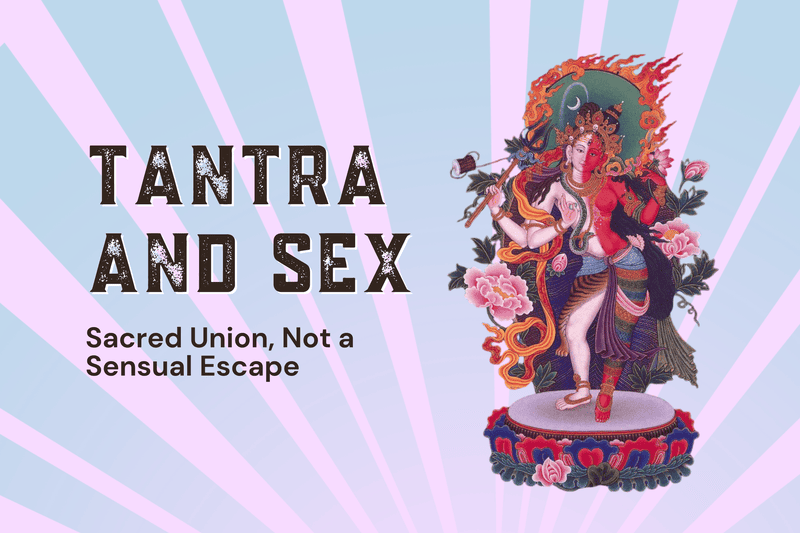In this blog, you’ll read about:
✨ The sacred origin of Kali Ghat Temple
🗿 The unique idol of Mahakali and the deeper symbolism of her weapons and mudras
🏛️ The temple’s architecture and what lies inside the sacred complex
🕯️ The daily worship rituals and special tantric observances that bring the temple to life
🧘🏽♀️ Saints and seekers who found divine communion here
📿 How modern devotees can begin their sadhana with Ma Kali
Where It All Began…
There are temples that stand as monuments, and there are temples that breathe like living beings.
The Kali Ghat Temple in Kolkata, West Bengal, is one such place—reverberating, mysterious, and eternal.
Step inside its narrow lanes, and you will hear not just the clamour of bells and chants but the pulse of a city that has grown around the feet of Mahakali herself.
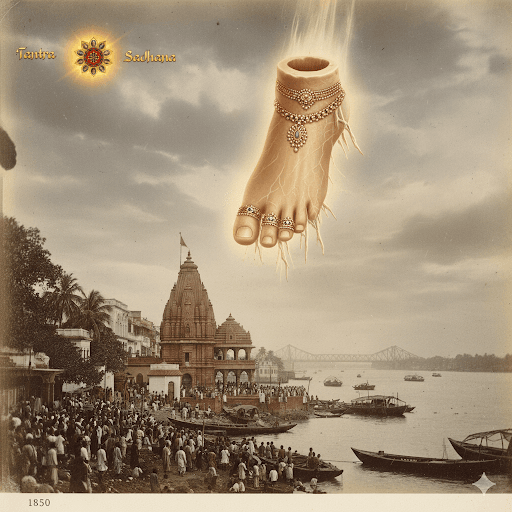
As the name suggests, the temple is dedicated to Kali Mata, one of the ten Mahavidyas (Ten Great Wisdoms) in the Hindu Tantric tradition.
Recognised as one of the 51 Shakti Pithas (Seats of Shakti / Abodes of Power), the Kali Ghat Temple is believed to mark the exact spot where a part of Devi Sati’s body fell, imbuing the land with immense spiritual power.
What Are Shakti Pithas?
The tale begins with Devi Sati’s father, Daksha Prajapati, organizing a grand Yagna (fire ritual), where he invited all the Gods and Goddesses — except Lord Shiva and Devi Sati.
His deliberate omission stemmed from deep-seated anger against them.
Unable to endure this disrespect, Devi Sati chose to visit the Yagna despite Lord Shiva’s warnings that the outcome would not be auspicious.
At the Yagna, what unfolded was heartbreaking. King Daksha berated Devi Sati for coming uninvited and insulted Lord Shiva, wounding Her deeply.
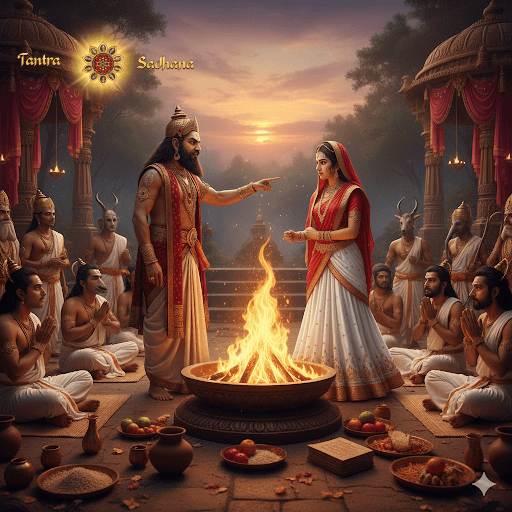
Unable to bear the humiliations hurled by Her own father in front of the divine assembly, She immolated Herself in the very fire ritual the king was conducting.
As Lord Shiva had warned, the outcome was catastrophic.
Grief-stricken and enraged, He began the Tandava — the cosmic dance of destruction — while carrying Devi Sati’s lifeless body in His arms.
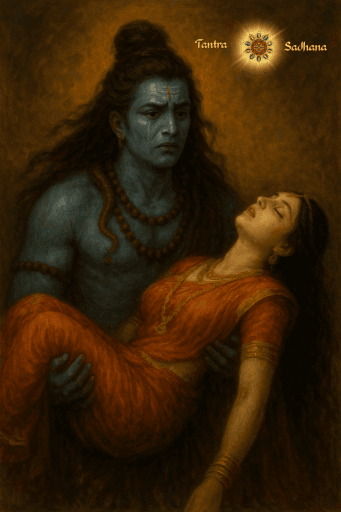
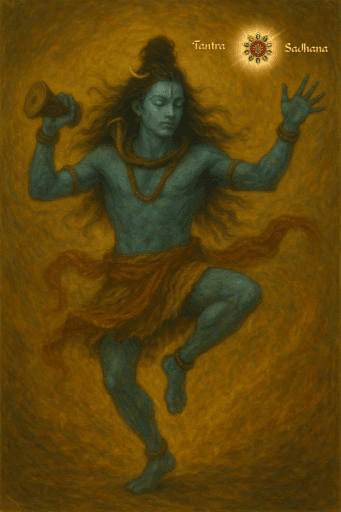
To pacify Lord Shiva and save the cosmos, Lord Vishnu used his Sudarshan Chakra to cut Her body into pieces.
According to the Devi Bhagavata Purana and the Kalika Purana, 51 parts of Her body fell across the Indian subcontinent.
Each spot where a part landed became a Shakti Pitha — a revered seat of divine feminine power.
The Kali Ghat Temple is believed to be the sacred site where the toes of Devi Sati’s right foot fell.
This story beautifully weaves together themes of grief, destruction, and rebirth.
The power of the temple emerges from the ashes of cosmic tragedy — suggesting that the most profound spiritual forces often arise from pain, loss, and transformation.
Story of Kali Maa — Etymology of the Name
The temple’s name, Kali Ghat — meaning “the landing place of Kali” — is deeply rooted in both its spiritual significance and geographic location.
It is believed that the temple originally stood on the banks of the Hooghly River, a prominent distributary of the Ganga. Over time, as the river shifted its course, the temple came to rest along the banks of what is now known as the Adi Ganga.
This sacred waterway holds immense religious importance. Even today, many devotees perform a holy dip in the Adi Ganga before stepping into the Kali Ghat temple complex, considering it a spiritual purification ritual before encountering Mahakali.
Story of Kali Maa — A Place of Divine Choosing & Popular Origin Stories
There are numerous stories about how the Kali Ghat Temple came into being. One of the most popular involves a Brahmin named Atma Ram, who noticed a toe-shaped structure floating in the Bhagirathi River.
People believe he was guided to it by a beam of divine light emerging from the water. Later, in a dream, he learned that the toe belonged to Devi Sati. He was asked to build a temple at the site and search for a Svayambhu Lingam (a self-manifested form of Shiva) of Nakuleshwar Bhairav.
Atma Ram eventually found the lingam and began worshipping it along with the toe-shaped relic.
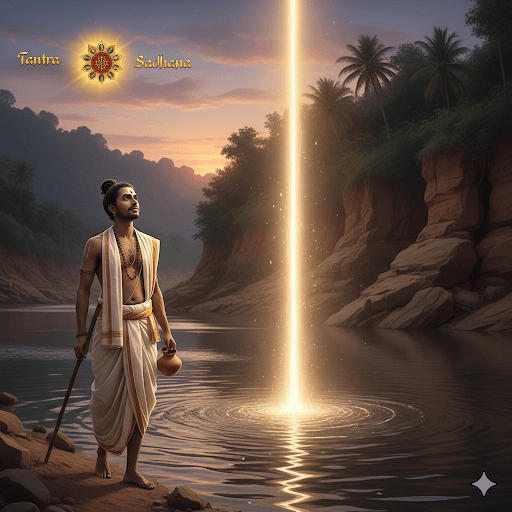
Another version of the origin story says that the idol of Kali Maa was originally discovered as a black stone, worshipped under the open sky. A skilled craftsman, inspired by spiritual visions, is said to have carved the current form of the goddess from that single slab of stone.
There are many such versions, some overlapping and others differing completely. But this only adds to the temple’s mystique — revealing a tapestry of faith, rather than a single fixed narrative.
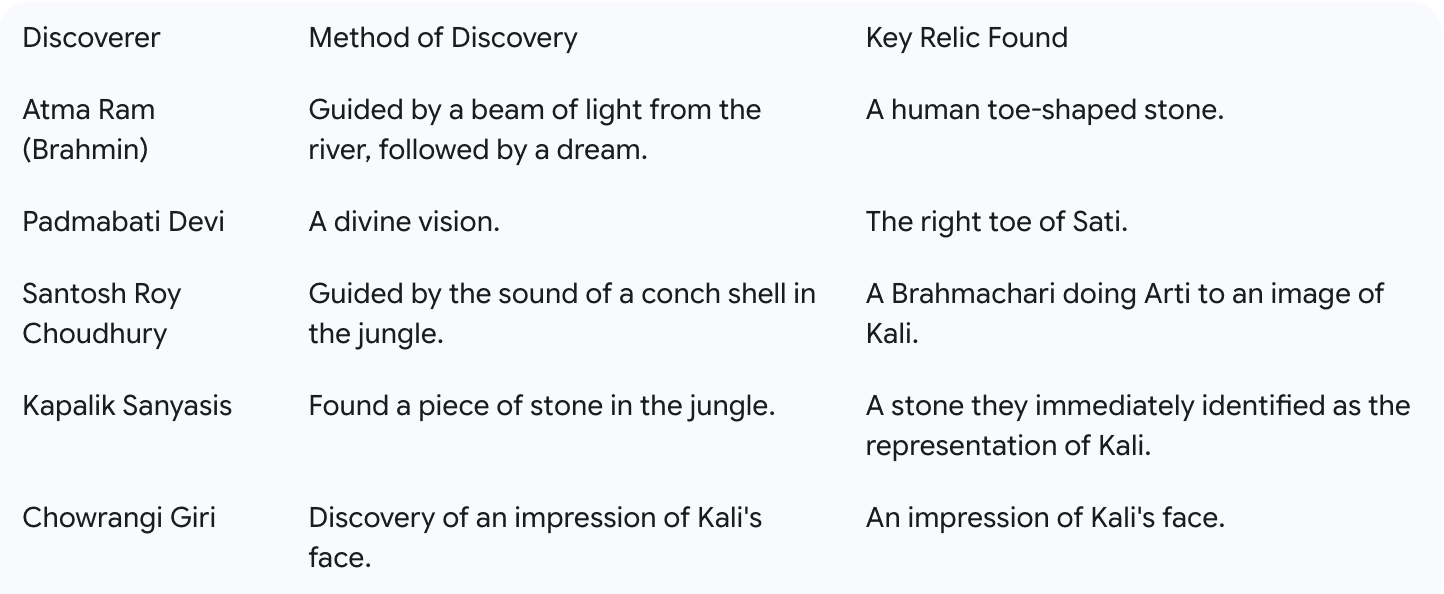
All these stories imply one truth: the site itself was always sacred. It was not man who chose the spot, but the Divine that chose to reveal itself there. The tales are simply accounts of those fortunate enough to witness and honour that revelation.
Initially, the temple was not a grand structure, but a small, hut-like shrine near the river. The present temple was constructed between 1809–1814 by the Sabarna Roy Chowdhury family of Barisha, a prominent zamindar family in Bengal.
Though the physical temple is only about 200 years old, literary references to it appear in much older texts — such as Mansar Bhasan (15th century) and Chandimangal by Kavi Kankan Mukundaram (17th century). These references serve as powerful evidence of the ancient and enduring sacredness of this mysterious shrine.
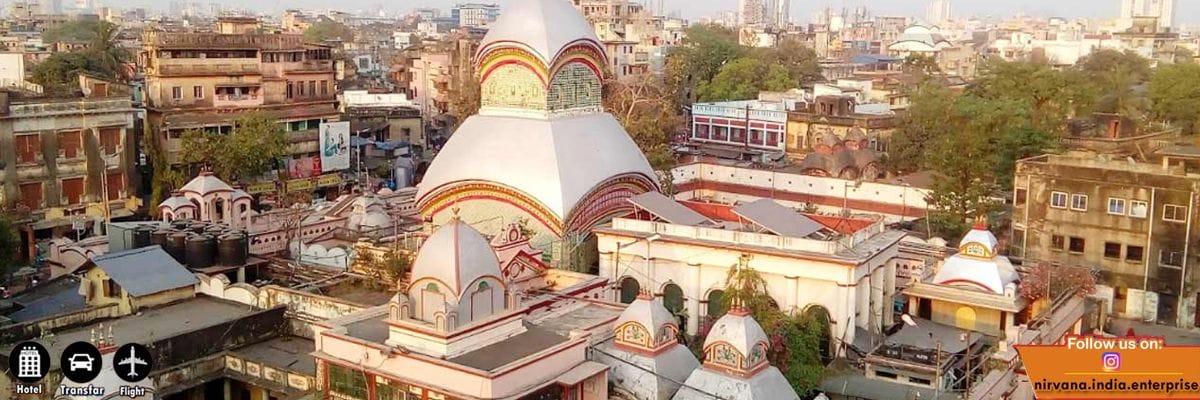
The Uniqueness of Kali Maa’s Statue
The idol of Maa Kali at Kali Ghat is unlike Her typical depictions found in most temples and images.
According to local lore, the original idol was incomplete—a black stone face with three eyes and a long protruding tongue, but no full body. Devotees continued to worship just Maa’s face, recognising her powerful presence even in this form.
The present Dakshina Kali idol of touchstone was crafted in 1570 CE by saints Brahmananda Giri and Atma Ram Giri based on the idol of Maa Bhuvaneshwari, the Kuladevi of Sabarna Roy Choudhury family.
Today, the idol has a complete form with:
- Three large eyes, symbolising past, present, and future
- A gold tongue extended in her signature expression
- Four hands: one holding a sword, one a severed head, and two in Abhaya and Varada Mudras (bestowing blessings and protection)
On the occasion of Snan Yatra (the ceremonial Bathing Festival), an extraordinary ritual takes place — the priests blindfold themselves before bathing the relic of Ma Sati, out of deep reverence for Her divine power.
Festivals like Kali Puja, Durga Puja, and Poila Boishakh (Bengali New Year) see thousands of devotees flocking to the temple to seek blessings from Kali Mata. Her fierce yet compassionate presence continues to draw seekers from all walks of life.
Kali Maa’s Statue – Symbolism of Her Ayudhas (Weapons and Tools)
The iconography of Kali Mata at Kali Ghat Temple is not just visually arresting—it is rich with spiritual meaning and Tantric wisdom.
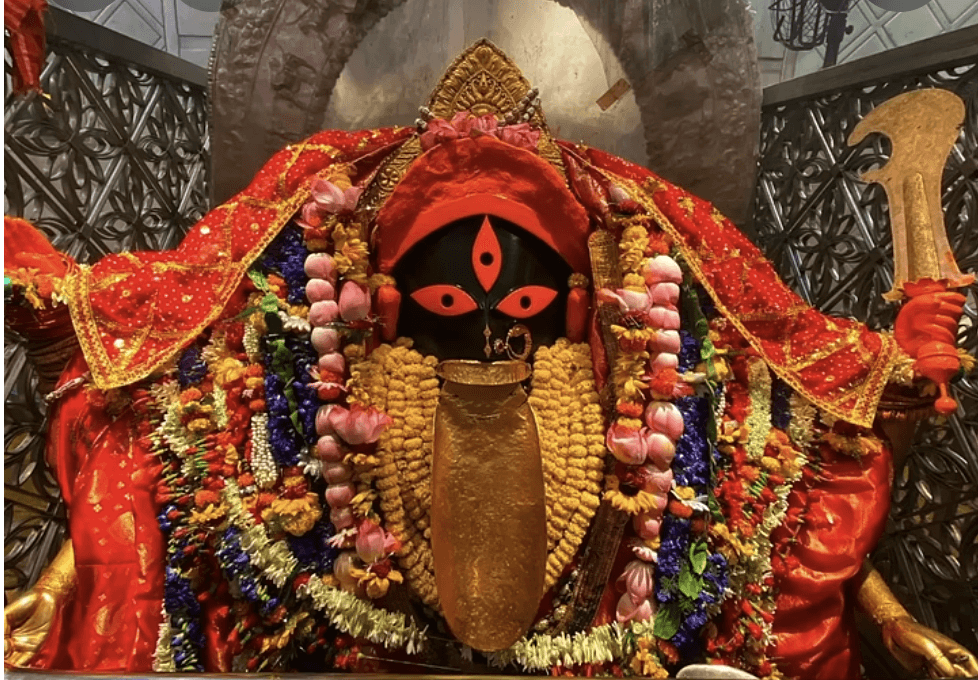
The Four Golden Hands
Of her four hands:
- Two are in Abhaya Mudra (granting fearlessness) and Varada Mudra (offering boons), symbolising protection and compassion.
- The other two hold a sword and a severed head, central to understanding Kali’s deeper message.
The Sword and the Severed Head
These two elements convey a profound truth:
- The sword stands for Divine Knowledge (Jnana)—the clarity that cuts through illusion.
- The severed head represents the human ego (Ahamkara)—the false identity we cling to.
Together, they teach us this core lesson: Liberation (Moksha) can only be attained by slaying the ego through the power of divine insight.
Ma Kali is not a destroyer of life, but a liberator of the soul. Her image is not terrifying—it is freeing.
The Hidden Toe of Sati
A lesser-known yet powerful secret lies beneath the idol.
Concealed within the pedestal of Kali Maa’s statue is a Svayambhu (self-manifested) relic—the original toe of Devi Sati.
It is never revealed to the public, nor even to the priests. This invisible sacred core reinforces the idea that the true source of spiritual power is often unseen—hidden, yet always present.
Just like Ma Kali herself, the temple invites us to look beyond the visible—to seek the truth that lies beneath the form.
Kali Ghat’s Architecture – A Sacred Blend of Earth and Spirit
The Kali Ghat Temple, dedicated to Mahakali, is not only spiritually potent—it is architecturally unique. Its form reflects the Bengal countryside’s soul, rooted in both rural simplicity and sacred complexity.
Ath-Chala Style – Bengal’s Architectural Legacy
The main sanctum follows the Ath-Chala (eight-roofed) style, a hallmark of Bengal’s traditional temple architecture:
- Inspired by the mud-and-thatch huts found in villages
- The temple has four sides and a truncated dome
- Three gold-topped spires crown the roof, symbolising divinity
- Metallic silver panels and vibrant colour bands add a festive yet sacred aesthetic
- Recent restorations feature terracotta motifs inspired by nature—bridging tradition with artistry
A Tour of the Temple Complex – Structures Within Kali Ghat
Beyond the sanctum, the Kali Ghat complex hosts several spiritually significant spaces:
1. Natmandir
A rectangular covered pavilion next to the main temple where devotees can have darshan (sight) of Kali Maa’s face from afar.
2. Jor Bangla
The verandah of the temple that faces the idol directly. From here, rituals in the garbhagriha (inner sanctum) can be viewed through the Natmandir.
3. Harkath Tala
A space for animal sacrifice:
- Two altars known as Hari-Kath:
- One for buffaloes
- One for goats and sheep
- Positioned adjacent to the Natmandir
4. Sosthi Tala (Monosha Tala)
A small sacred altar under a cactus plant represents three goddesses: Sosthi, Sitola, and Mongol Chandi
- All the priests here are women.
- There is No daily Bhog or puja. It is considered a space of quiet, ancestral power.
- It is also believed to be the Samadhi (final resting place) of the saint Brahmananda Giri.
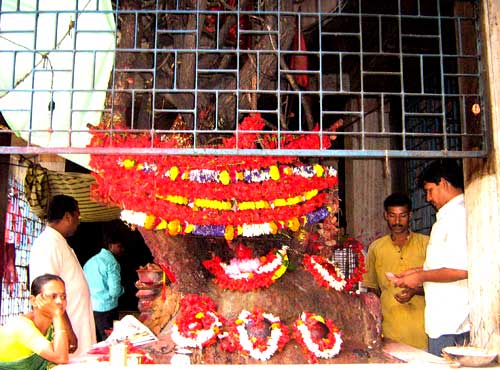
5. Nakuleshwar Bhairav Temple
A Lord Bhairav temple with a Svayambhu Lingam is situated in Haldar Para lane on the opposite side of the Kali Ghat Temple.
6. Radha-Krishna Temple (Shyam-ray Mandir)
An unexpected yet harmonious presence—this shrine reflects the plurality of devotion found within the complex.
7. Kundupukur (The Sacred Tank)
Situated to the southeast of the temple, outside its walls:
- Believed to be where Devi Sati’s toe was discovered
- Said to bestow the boon of a child to those who bathe or pray here with devotion
The architecture and spatial layout of Kali Ghat Temple do more than serve ritual function—they embody the layers of Tantra, Shakti worship, and rural devotion. Every pillar, tank, and altar is a reminder that Kali is everywhere—in the form, in the formless, in ritual, and in mystery.
Daily Worship of Maa Kali at Kali Ghat
At Kali Ghat, Maa Kali is not a statue — she is a living deity. Every day, the temple follows a sacred rhythm that mirrors the tender care one would offer to a loved one.
The Morning Ritual
- The day begins in deep devotion as priests wake the Goddess gently around 4:00 AM.
- She is bathed, anointed, and adorned with fresh garlands—especially red hibiscus, her favourite flower.
- By 5:00 AM, the Mangal Aarti is performed, and the doors open for darshan, allowing devotees to receive her gaze.
Afternoon Rest
- Between 2:00 PM and 5:00 PM, the temple closes. During this time:
- Bhog (sacred food offering) is presented to the Goddess.
- She is believed to rest, away from public view—a mark of deep respect and reverence.
Evening Worship
- At 5:00 PM, the temple reopens for the Sandhya Aarti (Evening Offering of Light).
- The temple remains open until 10:30 PM, giving devotees ample time to worship, pray, and connect.
Special Occasions & Sacred Nights
Festivals
During major festivals like:
- Kali Puja
- Diwali
- Navratri
…the temple transforms into a spiritual powerhouse. Tantric rituals, night-long prayers, and special offerings take place. The temple is decorated elaborately, pulsating with the energy of thousands who gather to honour the Divine Mother.
Amavasya (New Moon Nights)
- Considered extremely auspicious for Maa Kali
- Special midnight rituals are often performed, aligning with Her fierce, transformative energy.
The Ritual of Dondi
On festival days like Kali Pujo or Chhath Puja, some devotees perform Dondi—a physical act of penance and surrender:
- Devotees lie prostrate on the ground and slowly move forward towards the temple.
- Some crawl or drag themselves, inch by inch, as an offering of love, devotion, and humility.
This intense act is not forced—it is a voluntary vow, symbolic of one’s soul inching closer to the Divine through effort and surrender.
In Kali Ghat, worship isn’t just ritual—it is relationship. From the morning wake-up to the midnight chants, the temple breathes with the presence of the Mother, and her children come not just to worship—but to be seen, held, and transformed.
Saints Who Bowed at the Kali Ghat Temple
Kali Ghat has never been just a structure of stone and rituals. It is a living river of devotion, pulling into its orbit saints, tantrics, monks, and mystics — seekers whose hearts burned with longing for the Divine.
Here are just a few of the great souls who bowed before Maa Kali in this sacred space:
Sri Ramakrishna Paramahamsa
As a young priest, he stood before the black stone image of Maa Kali… and saw no stone. He saw the Living Mother.
In trance-like states, he would laugh, cry, dance, and speak to her like a child to his mother. Kali Ghat was where his divine madness first bloomed, where devotion spilled beyond ritual and became ecstasy.
Bamakhepa — The Tantric Saint of Tarapith
Clad in ash, hair wild, eyes blazing with love—he startled onlookers on his pilgrimage to Kali Ghat. But when he gazed upon Maa, there was no fear. In her, he saw only the soft gaze of a mother, not the terrifying destroyer others feared.
Chaitanya Mahaprabhu
The golden Vaishnava saint, ever lost in Krishna’s name, is believed to have bowed at Kali Ghat during his travels.
His followers say he recognised the same Divine in Maa Kali’s fierce form as in Lord Krishna’s playful dance in Vrindavan. For him, all forms were but waves on the ocean of Bhakti.
Swami Vivekananda
After conquering the West with the message of Vedanta, he returned home—exhausted, but ablaze.
In the silence of Kali Ghat, he bowed before Maa Kali. He asked for strength to carry out the mission given by his Master, Ramakrishna.
And the Mother answered.
The Living Flame
To visit Kali Ghat is to stand in paradox:
The chaos of crowds, the clang of bells, the scent of incense, the bleating of goats, the roll of drums… And yet, at the heart of it all, silence. In the sanctum, the Mother’s gaze meets your own — piercing, forgiving, all-consuming.
Kali Ghat is not just a temple. It is Kolkata’s spiritual pulse, a place where myth, memory, and modern life flow into one.
Here, Maa is not distant. She is raw. She is real. She is present. And anyone who meets her gaze carries her fire forever.
Praying to Maa Kali — A Modern Seeker’s Starting Point
For those who feel called to Maa Kali’s fierce grace but are unsure where to begin — you don’t need elaborate fire offerings, precise mantra chanting, or a formal initiation by a Guru.
All you need is devotion and discipline.
The Tantra Sadhana App offers an easy, accessible, and authentic path for beginners to connect with the Divine Mother through guided daily practice.
- 🌑 It begins with self-initiation — a preparatory stage designed for sincere seekers.
- 🕉️ Then it leads you through the main Sadhana of each Mahavidya, starting with Maa Kali.
- 🌺 You are free to focus solely on Kali Maa’s practice if She is the one calling you.
Created by Om Swami, a Himalayan monk who has completed over 15,000 hours of deep meditation and mastered various Vedic and Tantrik Sadhanas, the app is a free offering for those walking the spiritual path with sincerity.
Whether you are a curious beginner or a devoted seeker, may your journey to the Divine Mother be bold, beautiful, and blessed.
Jai Maa Kali!

